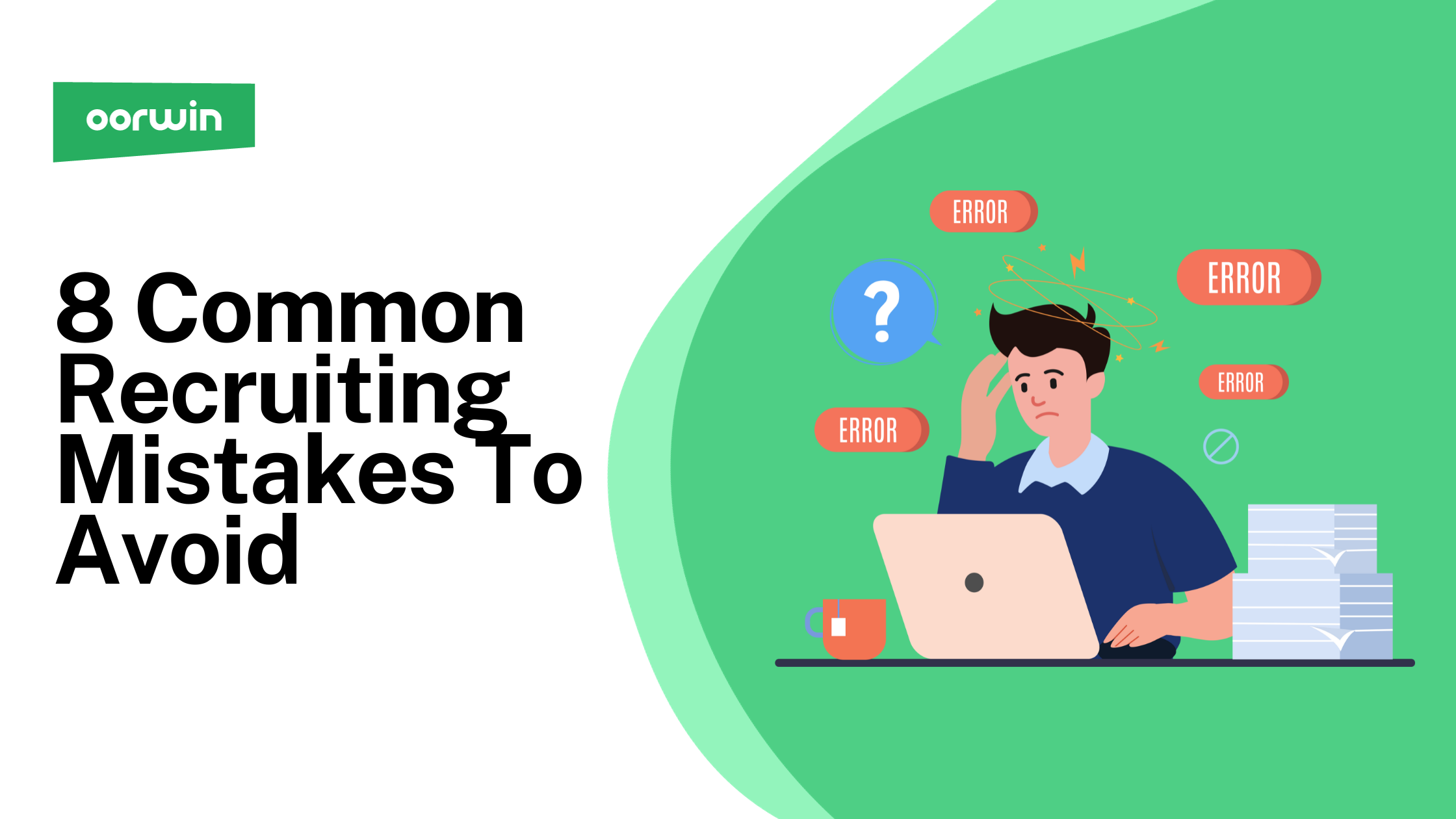8 Common Recruiting Mistakes To Avoid
Oorwin
9min read / 31 Oct 2023

Related Articles
Mastering the Art of Recruitment: Avoiding These 8 Common Recruiting Mistakes
Recruitment is a crucial element of any successful organization. It’s identifying, attracting, and onboarding the right talent to drive your company’s growth and success. However, despite its significance, recruitment can often be marred by several common mistakes. This article will delve into the eight most prevalent recruiting blunders and explore how you can avoid them to ensure you’re making the best hiring decisions for your organization.
8 Common Hiring Mistakes in Recruitment to Avoid
Recruitment is more than just posting job openings and conducting interviews. It’s a multifaceted process that requires careful planning, execution, and continuous improvement. Avoiding these common pitfalls can make your recruitment process more effective and efficient.
Inadequate Job Descriptions
Job descriptions serve as the first point of contact between potential candidates and your organization. Inadequate job descriptions often need to provide a clearer understanding of the role and its expectations. Candidates might apply with inaccurate expectations, leading to mismatched hires. To avoid this, ensure job descriptions are detailed, accurate, and reflect the skills, experience, and qualifications required for the role.
Rushing the Hiring Process
The urgency to fill open positions in a competitive job market can lead to hasty decisions. Rushing the hiring process can result in hiring candidates who must fit the job or the company culture. Take the time to thoroughly evaluate candidates, even if it means leaving a position open for a little longer. A well-considered hire is worth the wait.
Ineffective Interviewing Techniques
Interviews are a critical part of the hiring process, but if not conducted effectively, they can lead to poor hiring decisions. Interviewers may focus too much on surface-level traits or engage in unstructured interviews that fail to uncover a candidate’s true potential. Instead, use structured interview techniques with well-thought-out questions to assess a candidate’s skills, experience, and fit for the organization.
Skipping Reference Checks
Reference checks are often treated as a formality, but they are a valuable source of information about a candidate’s past performance and work habits. Skipping reference checks can result in hiring someone with a history of underperformance or issues with teamwork. Ensure you contact references and ask meaningful questions to gain insights into the candidate’s abilities and work ethic.
Unconscious Bias
Unconscious bias can subtly influence hiring decisions. It can lead to hiring choices based on personal preferences rather than objective qualifications. Implementing blind recruitment processes and unconscious bias training for hiring teams can help reduce these biases and promote diversity and inclusion within your organization.
Neglecting Cultural Fit Assessment
While skills and qualifications are essential, cultural fit is equally crucial. Neglecting to assess how well a candidate aligns with your company’s values and culture can lead to discord within the team.
Incorporate cultural fit assessment with Oorwin into your interview process to ensure that candidates have the right skills and mesh well with the existing team.
Failing to Adapt to Changing Practices
The world of recruitment is dynamic, and best practices are constantly evolving. Adapting to these changes can leave your organization behind in the talent acquisition game. Stay informed about the latest trends, technologies, and strategies in recruitment to remain competitive and attract top talent.
Neglecting Internal Talent for Recruitment
Internal talent often goes overlooked in favor of external hires. Neglecting your internal talent pool can lead to demotivated employees and missed growth opportunities. Encourage internal mobility by promoting from within when suitable candidates are available. This boosts employee morale and saves time and resources on external hiring.
In conclusion, recruitment is an art that, when done right, can transform your organization.
By avoiding these eight common recruiting mistakes, you can streamline your hiring process, attract the right talent, and build a cohesive, high-performing team. Remember, recruitment is an ongoing improvement process, so stay committed to refining your methods and adapting to the ever-changing talent acquisition landscape.
Frequently Asked Questions
What are the most common recruiting mistakes that organizations make?
Common recruiting mistakes include insufficient job descriptions, neglecting diverse sourcing, inadequate employer branding, and rushing the hiring process.
Why is cultural fit assessment important in the recruitment process?
Cultural fit assessment is vital to ensure candidates align with the company’s values, fostering team cohesion, reducing turnover, and enhancing overall organizational success.
How can I avoid making these recruiting mistakes?
To avoid these recruiting mistakes, improve job descriptions, diversify sourcing channels, invest in employer branding, establish a structured hiring process, and prioritize cultural fit assessment during interviews.
Popular Articles..
Blog

7min read / 25-Jun-2025
Master Effective Interview Techniques with Oorwin: A Step-by-Step Recruiter’s Guide
Blog
Blog
Get the latest Oorwin releases, updates, success stories & industry news
 Back
Back

